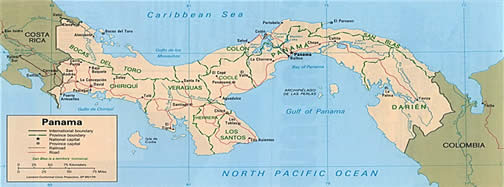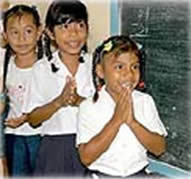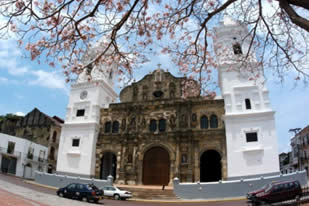| Home > Panama |
"No tenemos ningún proyecto de voluntariado en este País .
Por el momento, por favor visite nuestros proyectos en otros países,pero tenga en cuenta
que nuestra oferta se actualizará pronto!"
PANAMA:
Perfil de Panamá
La República de Panamá es el país más meridional de Centroamérica y está situado en el istmo que une América del Norte y América del Sur; limita al noroeste con Costa Rica, al sureste con Colombia, al norte con el mar Caribe y al sur con el océano Pacífico.
|
☻Capital: - Ciudad de Panamá ☻Area: - Total: 1.098.581 km² ☻Independencia: - De España: 28 noviembre, 1821 - De Colombia: 3 noviembre, 1903 |
☻Idiomas oficiales: - Español; el inglés se habla en las grandes ciudades. ☻Population: - Julio 2008 estimada 3.309.679 - Mayo 200 censo 2.839.177 - Densidad: 43/km² |
Geografía de Panamá:
 Panamá es el país más meridional de Centroamérica, es un istmo de 77.000 kilómetros cuadrados que conecta América del Norte con América del Sur; la autopista que atraviesa la parte mas estrecha mide solamente 100 kilómetros, un bañista podría darse un chapuzón en el Atlántico, subirse a su auto y darse otro remojón en el Pacífico en menos de hora y media.
Panamá es el país más meridional de Centroamérica, es un istmo de 77.000 kilómetros cuadrados que conecta América del Norte con América del Sur; la autopista que atraviesa la parte mas estrecha mide solamente 100 kilómetros, un bañista podría darse un chapuzón en el Atlántico, subirse a su auto y darse otro remojón en el Pacífico en menos de hora y media.It is located within the world's torrid or tropical zone, between 7 and 9 degrees of northern latitude and 77 and 83 degrees of western latitude. As a tropical country, Panama enjoys (suffers!) a hot climate. The temperature in Panama fluctuates around 22 to 31 degrees centigrade nearly all the year. Temperatures are higher in July and August in step with the northern summer. In the highest areas of the country the average temperature is about 19 degrees. There are two distinct seasons. The dry season; lasting from January until March and the rainy season the rest of the year. The rainy season is not extreme, it does not mean it does not stop raining! You simply know that almost every day there might be rain (but not necessarily), sometimes short, sometimes lasting several hours.
The topography of Panama is rugged and mountainous. A mountain chain travels lengthwise across the country and rises to a height of over 3,000 meters in the west, where it is a prolongation of the high mountains of Costa Rica. Panama's most towering peak is Volcan Barú, an extinct volcano in the western province of Chiriqui, at 3,475 meters. The mountain chain descends in uneven fashion down to the metropolitan area where the Canal is carved through hills about 100 meters high. To the east of the city the mountains gradually ascend again until reaching 2,000 meters before penetrating the Colombian frontier and eventually joining the cordillera of the Andes.
Apart from its privileged geographical position, Panama has among its principal resources an abundance of water. Some 150 rivers empty along the Atlantic Coast. Among the most important are the Changuinola (140 kms.), the Indio (99 kms.), and the Chagres (92 kms.). About 350 rivers flow into the Pacific. The most important are the Bayano (280 kms.), the Chucunaque (242 kms.), and the Tuira (230 kms.).In the jungle areas of Panama there is an extraordinary variety of insects, birds, reptiles and mammals. Marine life is extremely abundant and varied along the coasts of both oceans. Also there is a great diversity of trees, shrubs, grass and plants throughout the isthmus.
Educación en Panamá:
 Panama Education includes a large number of schools, colleges and universities. Elementary education is compulsory and free for children between ages 6 and 15. The period of primary Education is 6 years and the period of secondary education is 3 years.
Panama Education includes a large number of schools, colleges and universities. Elementary education is compulsory and free for children between ages 6 and 15. The period of primary Education is 6 years and the period of secondary education is 3 years.One-third of Panamanians age 25 and older have not completed primary school, yet it is estimated that nine-tenths of the adult population (age 15 and older) is literate. The institutions of higher education include the state-run University of Panamá (founded 1935) and the privately operated University of Santa María la Antigua (1965), both in Panama City; the University of Panamá also has branches in several provinces. A polytechnic university was founded in Panama City in 1981. In addition, some U.S. and other foreign universities offer branch programs in Panama.
Public education began in Panama soon after independence from Colombia in 1903 and started making progress in the year 1920, explicitly designed to assist the able and ambitious individual search of upward social mobility. Successive national governments gave a high priority to the developmentof a system of (at least) universal primary education; in the late 1930s, as much as one-fourth of the national budget went to education. Between 1920 and 1934, primary-school enrollment doubled. Adult illiteracy, more than 70 percent in 1923, dropped to roughly half the adult population in scarcely more than a decade. By the early 1950s, adult illiteracy had dropped to 28 percent, but the rate of gain had also declined and further improvements were slow in coming .There were notable gains in the 1960s, however, and the rate of adult illiteracy dropped 8 percentage by 1970. According to 1980 estimates, only 13percent of Panamanians over 10 years of age were illiterate.
As of the 2004/2005 school year there were about 430,000 students enrolled in grades one through six (95% attendance).The total enrollment in the six secondary grades for the same period was 253,900 (60% attendance) More than 90% of Panamanians are literate.
Among South America Education a lot of improvements have been noticed on Panama Education.
Salud en Panamá:
 Panama’s reputation as the most health-conscious country in Latin America dates back to the construction of the Panama Canal when the Isthmus was freed from tropical diseases. Not only did U.S. doctors help to eradicate malaria, yellow fever and typhoid; they inspired generations of Panamanian physicians to train in the US and Europe and return to their homeland to build hospitals with the latest technology.
Panama’s reputation as the most health-conscious country in Latin America dates back to the construction of the Panama Canal when the Isthmus was freed from tropical diseases. Not only did U.S. doctors help to eradicate malaria, yellow fever and typhoid; they inspired generations of Panamanian physicians to train in the US and Europe and return to their homeland to build hospitals with the latest technology. Panama counts 11 medical complexes and around 45% of Panama physicians are located in Panama City. Panama offers good-quality medical care and modern hospitals in the metropolitan area, however, the more isolated the location, the harder it is to access these services. The hospitals offer first-rate medical care. Many Panamanian doctors are U.S. trained, and the standards at the top hospitals compare favorably to those in the United States.
Alternative and complementary and preventative medicine is also well-represented in Panama. In the two Chinatowns of Panama city, practitioners prescribe imported herbs which are available in Chinese Supermarkets. Acupuncture has its own professional body here -a branch of the Circulo de Investigadores de Acupunctura de China.
Other disciplines include Homeopathy, Homotoxology, Herbal Medicine, Prolotherapy, Intravenous Quelation, Magnetotherapy, Manual Therapies (Chiropractic, Reibi).
Política en Panamá:
 For most of the 20th century, Panama was a constitutional democracy. However, a coup in 1968 brought the military to power. During the 1980s, Panamanian General Manuel Noriega assumed control of the government. After diplomatic and economic pressure failed to remove Noriega, U.S. president George Bush used American troops to remove the dictator from power and restore democracy in 1991 in a military operation known as "Just Cause."
For most of the 20th century, Panama was a constitutional democracy. However, a coup in 1968 brought the military to power. During the 1980s, Panamanian General Manuel Noriega assumed control of the government. After diplomatic and economic pressure failed to remove Noriega, U.S. president George Bush used American troops to remove the dictator from power and restore democracy in 1991 in a military operation known as "Just Cause."Panama is now a constitutional representative democracy. The government is divided into 3 branches: executive, legislative, and judicial. The executive branch is led by an elected president who serves as both the head of state and the head of the government. The president is elected for a 5-year term and appoints the national cabinet.
Because of its history of military interference in the government, the nation adopted a constitutional amendment in 1994 which abolished the military. Security is now in the hands of the national police force, the coast guard, and a national air service. In 1997, the government spent 1.9 percent of the nation's GDP on security or about US$132 million. About 150,000 people work for the government in some capacity
The largest political party in Panama is the Democratic Revolutionary Party (PRD). The PRD is conservative on economic matters and appeals mainly to the country's young and urban poor. The Arnulfista Party (PA) is the party of the nation's current president and its base is among the Panama's rural population. The Popular Block is a coalition of former Christian Democrats and pro-business groups, as is the National Liberal Republican Movement and Democratic Change. These parties appeal to the middle and upper classes and tend to have strong ties to the business community.
During the 1990s, the government was engaged in a variety of programs to liberalize the economy .A number of previously government-owned businesses were privatized. These include the ports of Cristobal and Balboa; the nation's telecommunications company, INTEL; power generation facilities; and a cement company. In addition, the government has privatized the nation's 17 casinos and slot-machine companies. Plans to privatize the electric and water companies were halted by a new government in 1999. Because the nation uses the U.S. dollar, it cannot control its monetary policy.